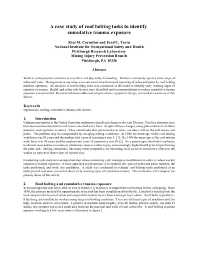Mining Publication: A Case Study of Roof Bolting Tasks to Identify Cumulative Trauma Exposure
Original creation date: March 2001
Work in underground coal mines is repetitive and physically demanding. Workers commonly report a wide range of aches and pains. Management at one mine was concerned about increased reporting of aches and pains by roof bolting machine operators. An analysis of roof bolting tasks was conducted at this mine to identify early warning signs of cumulative trauma. Health and safety risk factors were identified and recommendations to reduce cumulative trauma exposure were provided. Recommendations addressed job procedures, equipment design, and worker awareness of risk factors.
Authors: KM Cornelius, FC Turin
Conference Paper - March 2001
NIOSHTIC2 Number: 20022681
Proceedings of the IIE 10th Annual Research Conference (March 19-21, 2001. Denver, Co); :6 pp
See Also
- An Analysis of Roof Bolter Fatalities and Injuries in U.S. Mining
- Directional Control-Response Compatibility Relationships Assessed by Physical Simulation of an Underground Bolting Machine
- Ergonomic Assessment of Musculoskeletal Risk Factors at Four Mine Sites: Underground Coal, Surface Copper, Surface Phosphate, and Underground Limestone
- Machine Injury Prediction by Simulation Using Human Models
- Manual Materials Handling
- Musculoskeletal Stress on Miners Performing Roof Screening Operations
- Musculoskeletal Symptoms Among Operators of Heavy Mobile Equipment
- Practical Demonstrations of Ergonomic Principles
- Repeatability of a Checklist for Evaluation Cab Design Characteristics of Heavy Mobile Equipment
- Toward a Typology of Dynamic and Hazardous Work Environments
- Using Ergonomics To Enhance Safe Production At a Surface Coal Mine - A Case Study With Powder Crews
- Page last reviewed: 9/21/2012
- Page last updated: 9/21/2012
- Content source: National Institute for Occupational Safety and Health, Mining Program


 ShareCompartir
ShareCompartir
